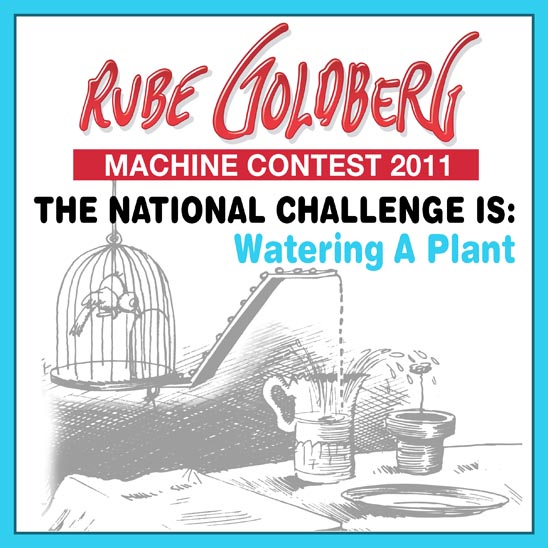The spirit of Rube Goldberg’s bizarre cartoon creations of overly complex machines designed to accomplish simple tasks comes to life at the Cradle of Aviation Museum in Garden City this Saturday, Feb 12, in a contest bearing the wry illustrator’s name.
Nine teams from Long Island high schools, including Baldwin High School, Wantaugh High School, Lynbrook High School and six teams from Riverhead High School will compete in a regional run-up to the national high school finals at Ferris State University, in Big Rapids, MI on March 19.
For the uninitiated, Rube Goldberg was a nationally syndicated cartoonist who started publishing his humorous multi-step machinations to accomplish common tasks in the New York Evening Mail. For example, his solution for how to tee up a golf ball without bending over involves firing a gun to startle a groundhog into jumping back into its hole, which triggers a cannonball tied to the groundhog to drop on an atomizer, which sprays a shirt tied to a set of tongs, which – as the shirt gently shrinks – drops a golf ball onto a tee.
You get the idea (see illustration). Goldberg, who held an engineering degree from the University of California Berkeley, worked for the San Francisco Sewers Department before deciding it would be more fun to draft cartoons of his imagined sequential inventions. His name is now a dictionary adjective for unnecessarily complex devices.
The idea of the annual contest is to challenge young engineering minds to implement like-minded constructions for real. The objective in this year’s contest is to water a plant in a sequence of at least 20 steps, with points awarded for general impression, explanation, style – how well steps are designed to use everyday items – and extra points for creativity.
“Because we stress science and engineering, what better thing to do than to have these kids create these wacky inventions,” said Rick Angler, an educator at the Cradle of Aviation Museum. “This gives science clubs a perfect outlet to compete against other schools.”
It also provides an opportunity for visitors to the museum to view what are certain to be an amusing conglomeration of machines that will be set up for two-minute demonstrations on Saturday morning by teams of 10 to 14 students each. They are gathering to have their inventions judged by a panel, including museum docents and engineers from Grumman Corp. – real-life rocket scientists who helped design the NASA lunar module.
“While the judges are tabulating the results, the public gets to walk around the machines, ask questions of the teams and see the machines in action,” Angler said.
The fun starts when the museum opens at 10 a.m. It’s serious fun for the young engineers, with each team putting up $300 to enter the contest. The national winner will likely enjoy a cameo appearance with David Letterman or Jay Leno, and the regional winners will at least advance with the certain knowledge that they have concocted a perfectly ridiculous way to water a plant.
If you can’t make it to the museum this weekend, there is more fun in store in programs targeted for youngsters during Green Energy Week, Feb. 21-25, that winter school break week when parents may be seeking ways to keep the kids amused.
In the Cradle’s Wind Workshop, from noon to 4 p.m. daily that week, visitors will be able experiment with different types of propeller blades to see how they spawn wind power.
“It’s timely and it’s relevant to see how these things work,” said Angler, who added that the demonstrations will seek to convey the importance of developing alternative energy sources to replace fossil fuels.
Kids can go on a treasure hunt to see how many propellers they can find in the museum.
There are a lot of them to find, including a Bleriot, one of the earliest flying machines that was actually used on the nearby Hempstead Plain as a vehicle
testing wannabe pilots for the first licenses issued. There is also a World War I era Curtiss-Jenny that was repaired by Charles Lindbergh.
The museum’s family craft corner assumes a “green” theme, providing the materials to make takeaways, including koi fish windsocks, breeze spinners and working windmills.
Museum staff members will also be roving around with “discovery carts” of real-life equipment for a hands-on experience, including space suits and helmets to be examined and tried on by visitors.
In a more passive space-age vein, visitors can check out the museum’s prototype of the lunar module that transported astronauts to the surface of the moon.
So there are plenty of opportunities to enable visitors’ imaginations, both young and old, to be transported through time in the museum’s myriad exhibits on the history of man’s realizations of that age-old aspiration to take flight.



